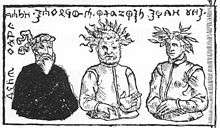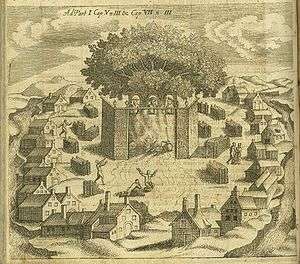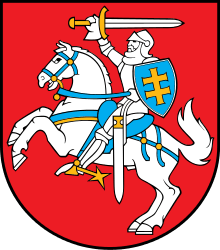Lithuanian mythology
Lithuanian mythology is the mythology of Lithuanian polytheism, the religion of pre-Christian Lithuanians. Like other Indo-Europeans, ancient Lithuanians maintained a polytheistic mythology and religious structure. In pre-Christian Lithuania, mythology was a part of polytheistic religion; after the christianisation mythology survived mostly in folklore, customs and festive rituals. Lithuanian mythology is very close to the mythology of other Baltic nations and tribes and is being considered a part of the Baltic mythology.
Sources
The first bits about Baltic religion were written down by Herodotus, Tacitus. In the 9th century there is one attestation about Prussian funeral traditions by Wulfstan.
History of scholarship
Surviving information about Baltic paganism in general is fragmented. As with most ancient Indo-European cultures (e.g. Greece and India), the original primary mode of transmission of seminal information such as myths, stories, and customs was oral, the then-unnecessary custom of writing being introduced later during the period of the text-based culture of Christianity. Most of the early written accounts are very brief and made by foreigners, usually Christians, who disapproved of pagan traditions. Some academics regard some texts as inaccurate misunderstandings or even fabrications. In addition, many sources list many different names and different spellings, thus sometimes it is not clear if they are referring to the same thing.

Lithuania became Christianized between the end of the 14th century and the beginning of the 15th century, but pagan religions survived for another two centuries, gradually losing cultural influence and coherence. The last conceptions of the old religion survived approximately until the beginning of the 19th century. The relics of the old polytheistic religion were already interwoven with songs, tales and other mythic stories. It was difficult to have a whole, solid view about Lithuanian mythology. Another difficulty in this process is that Lithuanian mythology was not static, but constantly developed, so that it did not remain in the same form over the longer periods usually treated by mythologists.
Many scholars preferred to write their own reconstructions of Lithuanian mythology, based also on historical, archaeological, and ethnographic data. The first such reconstruction was written by the Polish-speaking Lithuanian historian Theodor Narbutt at the beginning of the 19th century. Two well-known attempts at reconstruction have been attempted more recently by Marija Gimbutas and Algirdas Julien Greimas.
The most modern academics exploring Lithuanian mythology in the second half of the 20th century were Norbertas Vėlius and Gintaras Beresnevičius.
Relations with other mythological systems

Lithuanian mythology is perhaps closest to Latvian mythology, and according to the prevalent point of view, Lithuanians shared the same myths and basic features of their religion with the Old Prussians. On the other hand, individual elements have much in common with other mythological systems, and especially with those of neighbouring cultures.
There is a Finnic Mordvin/Erza thunder god named Pur’ginepaz which in folklore has themes resembling Lithuanian Perkunas. " Sparks fly from the cartwheels and the hooves of fiery-red horses of Pur’ginepaz, the Erza thunder god, when he drives across the sky " (Yurtov, A. 1883. Obraztsy mordovskoi narodnoi slovesnosti. 2nd ed. Kazan. p 129). In several mythical songs the thunder god Pur’ginepaz marries an earthly girl Litova (Lituva, Syrzha, etc.) (Jakov, O. 1848. O mordvakh, nakhodiashchikhsia v Nizhegorodskom uezde Nizhegorodskoi gubernii. Sankt Peterburg. p 59–60) These also closely resemble the Vedic Parjanya.
The periods of Lithuanian mythology
Pre-Christian mythology is known mainly through speculation and reconstruction, although the existence of some mythological elements, known from later sources, has been confirmed by archaeological findings. It is reflected in folk tales, such as Jūratė and Kastytis, Eglė the Queen of Serpents and the Myth of Sovius.
The next period of Lithuanian mythology started in the 15th century, and lasted till approximately the middle of the 17th century. The myths of this period are mostly heroic, concerning the founding of the state of Lithuania. Perhaps two the best known stories are those of the dream of the Grand Duke Gediminas and the founding of Vilnius,[1] the capital of Lithuania, and of Šventaragis, which also concerns the history of Vilnius. Many stories of this kind reflect actual historical events. In general, these myths are coloured by patriotism. Already by the 16th century, there existed a non-unified pantheon; data from different sources did not correspond one with another, and local spirits, especially those of the economic field, became mixed up with more general gods and ascended to the level of gods.[2]
The third period began with the growing influence of Christianity and the activity of the Jesuits, roughly since the end of the 16th century. The earlier confrontational approach to the pre-Christian Lithuanian heritage among common people was abandoned, and attempts were made to use popular beliefs in missionary activities. This also led to the inclusion of Christian elements in mythic stories.
The last period of Lithuanian mythology began in the 19th century, when the importance of the old cultural heritage was admitted, not only by the upper classes, but by the nation more widely. The mythical stories of this period are mostly reflections of the earlier myths, considered not as being true, but as the encoded experiences of the past. They concentrated on moral problems, and on a heroic vision of the past, rather than on individual heroes, who very often even lacked proper names, being referred to as "a duke", "the ruler of the castle", etc.
Elements of Lithuanian mythology
.jpg)
Gods and Nature
Stories, songs, and legends of this kind describe laws of nature and such natural processes as the change of seasons of the year, their connections with each other and with the existence of human beings. Nature is often described in terms of the human family; in one central example (found in many songs and stories), the sun is called the mother, the moon the father, and stars the sisters of human beings. Lithuanian mythology is rich in gods and minor gods of water, sky and earth.
Inner heroism
Lithuanian myths often reveal the inner heroism of a human being, symbolising this inner being in terms of various feats in the mystic lands on the opposite side of the Earth, or in the sky of the South polar regions, commonly describing these places as "The Land over All the Seas" and "The Cosmic Underwater Kingdom", respectively.
Gods of Morality
Myths that talk about problems of morality are the simplest, and are close to popular fables common to all European nations. The main idea in these stories is that a Goddess or God often visits people to guide them in moral questions, but people are not able to recognize her / him. According to these stories, a human should listen to his or her inner voice of harmony and justice, in order to act morally in the presence of a God / Goddess, for people do not know when and under what circumstances they are under his gaze. Some scholars stress the mixed Christian and pre-Christian character of these stories.
Legacy
Lithuanian mythology serves as a constant inspiration for Lithuanian artists. Many interpretations of Eglė - the Queen of Serpents were made in poetry and visual art. In modern Lithuanian music polytheistic rituals and sutartinės songs were source of inspiration for Bronius Kutavičius. Old Lithuanian names, related to nature and mythology are often given to the children.

See also
References
- ↑ "Legend of Founding of Vilnius". Archived from the original on 20 October 2007.
- ↑ Beresnevičius.
- Jūrate Baranova; et al., eds. (2001). "Chapter iv Lithuanian mythology by Gintaras Beresnevičius". Lithuanian philosophy: persons and ideas Lithuanian philosophical studies, ii. Cultural heritage and contemporary change series IVa, Eastern and Central Europe, volume 17. The Council For Research In Values And Philosophy. ISBN 1-56518-137-9. Archived from the original on 28 September 2007. Retrieved 7 September 2007.
Literature
- Gintaras Beresnevičius on periodisation and Gods in Lithuanian mythology.
- Algirdas Julius Greimas, "Of Gods and Men: Studies in Lithuanian Mythology", Indiana Univ. Pr. (November 1992). ISBN 978-0253326522
- List of Lithuanian Gods Found in Maciej Sryjkowski chonicle by Gintaras Beresnevičius
- Lithuanian Religion and Mythology by Gintaras Beresnevičius.
- Cosmology Of The Ancient Balts by Limbertas Klimka and Vytautas Straižys.
- (in Lithuanian) Rimantas Balsys. Lietuvių ir prūsų pagonybė: alkai, žyniai, stabai. Klaipėdos universiteto leidykla: 2015, Klaipėda. ISBN 9789955188513
- (In Lithuanian) Norbertas Vėlius. Baltų religijos ir mitologijos šaltiniai (Sources of Baltic religion and mythology), 4 volumes. Mokslo ir enciklopedijų leidybos centras: 1996–2005, Vilnius. ISBN 5-420-01518-8
- (In German) Adalbert Bezzenberger: Litauische Forschungen. Beiträge zur Kenntnis der Sprache und des Volkstums der Litauer. Peppmüller, Göttingen 1882.
- (In German) August Schleicher: Lituanica. Abhandlungen der Wiener Akademie, Wien 1854. (über litauische Mythologie)
- (In German) Edmund Veckenstedt (Hrsg.): Mythen, Sagen und Legenden der Zamaiten (Litauer). Heidelberg 1883 (2 Bde.).

